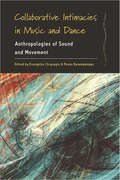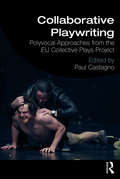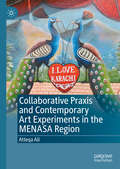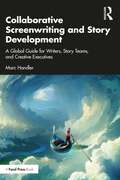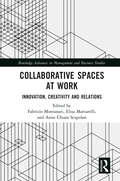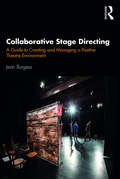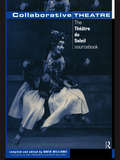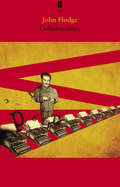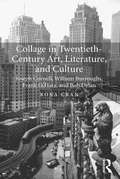- Table View
- List View
Collaborative Intimacies in Music and Dance: Anthropologies of Sound and Movement (Dance and Performance Studies #10)
by Evangelos Chrysagis and Panas KarampampasAcross spatial, bodily, and ethical domains, music and dance both emerge from and give rise to intimate collaboration. This theoretically rich collection takes an ethnographic approach to understanding the collective dimension of sound and movement in everyday life, drawing on genres and practices in contexts as diverse as Japanese shakuhachi playing, Peruvian huayno, and the Greek goth scene. Highlighting the sheer physicality of the ethnographic encounter, as well as the forms of sociality that gradually emerge between self and other, each contribution demonstrates how dance and music open up pathways and give shape to life trajectories that are neither predetermined nor teleological, but generative.
Collaborative Planning: Shaping Places in Fragmented Societies (Planning, Environment, Cities)
by Patsy HealeySpatial and environmental planning is an essential feature of all but the very simplest of societies. Its form and role and the principles on which it should be based, however, have become increasingly controversial questions. In this important book Patsy Healey draws on a wide range of new thinking in social, political and spatial theory to provide a framework for planning which is rooted in the institutional realities of our increasingly fragmented societies but designed to foster communication and collaborative action.
Collaborative Playwriting: Polyvocal Approaches from the EU Collective Plays Project
by Paul CastagnoIn Collaborative Playwriting, five collectively written plays apply polyvocal methods in which clash and frisson replace synthesis, a dialogic approach to collective writing that has never before been articulated or documented. Based on the EU Collective Plays Project, this collection of plays showcases each voice in dialogic tension and in relation to the other voices of the text, offering an entirely novel approach to new play development that challenges the single (and privileged) authorial voice. Castagno’s case-study approach provides detailed commentary on each of the various experimental methods, exploring the plays’ processes in detail. The book offers an evolutionary path forward in how to develop new work, thus encouraging and promoting the writing of collective, hybrid plays as having profound benefits for all playwrights. The ground breaking approaches to playmaking in Collaborative Playwriting will appeal to playwriting programs, instructors, academics, professional playwrights, theaters and new play development programs; as well as courses in gender LGBTQ studies, script analysis, dramaturgy and dramatic literature across the theater studies curricula.
Collaborative Playwriting: Polyvocal Approaches from the EU Collective Plays Project
by Paul C. CastagnoIn Collaborative Playwriting, five collectively written plays apply polyvocal methods in which clash and frisson replace synthesis, a dialogic approach to collective writing that has never before been articulated or documented. Based on the EU Collective Plays Project, this collection of plays showcases each voice in dialogic tension and in relation to the other voices of the text, offering an entirely novel approach to new play development that challenges the single (and privileged) authorial voice. Castagno’s case-study approach provides detailed commentary on each of the various experimental methods, exploring the plays’ processes in detail. The book offers an evolutionary path forward in how to develop new work, thus encouraging and promoting the writing of collective, hybrid plays as having profound benefits for all playwrights. The ground breaking approaches to playmaking in Collaborative Playwriting will appeal to playwriting programs, instructors, academics, professional playwrights, theaters and new play development programs; as well as courses in gender LGBTQ studies, script analysis, dramaturgy and dramatic literature across the theater studies curricula.
Collaborative Praxis and Contemporary Art Experiments in the MENASA Region
by Atteqa AliThis book examines the ways in which artists and arts organizations today forge collaborative, socially engaged situations that involve non-professionals in the process of making art, often over a period of time, through creating opportunities to examine collective concerns and needs. Collaborative art praxis is gaining prominence in the Middle East, North Africa, and South Asia (MENASA) region. This is a discursive method that is experimental, with results that often expand the notions of what art is—and how it can be produced. After an introduction to global approaches to such a practice, Ali examines the foundation of contemporary art in the MENASA that is linked to a longer history of colonialism. The book analyzes artist-led initiatives and community-based organizations through themes including relational aesthetics, war and violence, blight in marginalized places around the world, in addition to questions associated with art and its value in the fields of global contemporary art and society.
Collaborative Screenwriting and Story Development: A Global Guide for Writers, Story Teams, and Creative Executives
by Marc HandlerThis is a comprehensive guide to teach writing and story development from a collaborative global perspective. This book teaches writers how to take full advantage of emerging opportunities, both locally and globally. With an increasing number of international co-productions and many screenwriters now working collaboratively in writers rooms and development groups, author Marc Handler explains how to work cooperatively with others to break stories, plan seasons, create characters, and build series. To succeed, readers will learn how to give and receive feedback effectively, adapt to the style and constraints of executives and brands, and contribute to the team building process, all within an increasingly global media industry that is in constant flux. This book will help readers develop a global perspective, ensuring that they are prepared for new opportunities as they arise. Marc Handler provides cultural insight and understanding as he describes the fundamentals as well as advanced story skills. This book is essential reading for students taking classes such as Screenwriting Fundamentals, Writing for Film and TV, Introduction to Television Writing, and Advanced Screenwriting, as well as aspiring and early career screenwriters, showrunners, producers, and creative executives.
Collaborative Screenwriting and Story Development: A Global Guide for Writers, Story Teams, and Creative Executives
by Marc HandlerThis is a comprehensive guide to teach writing and story development from a collaborative global perspective. This book teaches writers how to take full advantage of emerging opportunities, both locally and globally. With an increasing number of international co-productions and many screenwriters now working collaboratively in writers rooms and development groups, author Marc Handler explains how to work cooperatively with others to break stories, plan seasons, create characters, and build series. To succeed, readers will learn how to give and receive feedback effectively, adapt to the style and constraints of executives and brands, and contribute to the team building process, all within an increasingly global media industry that is in constant flux. This book will help readers develop a global perspective, ensuring that they are prepared for new opportunities as they arise. Marc Handler provides cultural insight and understanding as he describes the fundamentals as well as advanced story skills. This book is essential reading for students taking classes such as Screenwriting Fundamentals, Writing for Film and TV, Introduction to Television Writing, and Advanced Screenwriting, as well as aspiring and early career screenwriters, showrunners, producers, and creative executives.
Collaborative Spaces at Work: Innovation, Creativity and Relations (Routledge Advances in Management and Business Studies)
by Fabrizio Montanari Elisa Mattarelli Anna Chiara ScapolanCollaborative spaces are more than physical locations of work and production. They present strong identities centered on collaboration, exchange, sense of community, and co-creation, which are expected to create a physical and social atmosphere that facilitates positive social interaction, knowledge sharing, and information exchange. This book explores the complex experiences and social dynamics that emerge within and between collaborative spaces and how they impact, sometimes unexpectedly, on creativity and innovation. Collaborative Spaces at Work is timely and relevant: it will address the gap in critical understandings of the role and outcomes of collaborative spaces. Advancing the debate beyond regional development rhetoric, the book will investigate, through various empirical studies, if and how collaborative spaces do actually support innovation and the generation of new ideas, products, and processes. The book is intended as a primary reference in creativity and innovation, workspaces, knowledge and creative workers, and urban studies. Given its short chapters and strong empirical orientation, it will also appeal to policy makers interested in urban regeneration, sustaining innovation, and social and economic development, and to managers of both collaborative spaces and companies who want to foster creativity within larger organizations. It can also serve as a textbook in master’s degrees and PhD courses on innovation and creativity, public management, urban studies, management of work, and labor relations.
Collaborative Spaces at Work: Innovation, Creativity and Relations (Routledge Advances in Management and Business Studies)
by Fabrizio Montanari Elisa Mattarelli Anna Chiara ScapolanCollaborative spaces are more than physical locations of work and production. They present strong identities centered on collaboration, exchange, sense of community, and co-creation, which are expected to create a physical and social atmosphere that facilitates positive social interaction, knowledge sharing, and information exchange. This book explores the complex experiences and social dynamics that emerge within and between collaborative spaces and how they impact, sometimes unexpectedly, on creativity and innovation. Collaborative Spaces at Work is timely and relevant: it will address the gap in critical understandings of the role and outcomes of collaborative spaces. Advancing the debate beyond regional development rhetoric, the book will investigate, through various empirical studies, if and how collaborative spaces do actually support innovation and the generation of new ideas, products, and processes. The book is intended as a primary reference in creativity and innovation, workspaces, knowledge and creative workers, and urban studies. Given its short chapters and strong empirical orientation, it will also appeal to policy makers interested in urban regeneration, sustaining innovation, and social and economic development, and to managers of both collaborative spaces and companies who want to foster creativity within larger organizations. It can also serve as a textbook in master’s degrees and PhD courses on innovation and creativity, public management, urban studies, management of work, and labor relations.
Collaborative Stage Directing: A Guide to Creating and Managing a Positive Theatre Environment
by Jean BurgessCollaborative Stage Directing: A Guide to Creating and Managing a Positive Theatre Environment focuses on the director’s collaboration with actors and the creative team, and the importance of communication and leadership skills to create and manage a healthy working environment. Speaking directly to the student, this compact resource walks the aspiring director through basic principles of group dynamics, active listening, open-ended questioning, brainstorming, and motivational leadership, supported by examples and case studies offered by current professional and academic directors. With a focus on preparing the student director for resume-building opportunities beyond the studio lab, Collaborative Stage Directing challenges readers with reflective activities, a series of guiding questions to apply to three short plays, and an extensive checklist to assist them with independent directing projects. As an easy-to-use resource, Collaborative Stage Directing works as a supplement to a classic directing text or as a stand-alone guide.
Collaborative Stage Directing: A Guide to Creating and Managing a Positive Theatre Environment
by Jean BurgessCollaborative Stage Directing: A Guide to Creating and Managing a Positive Theatre Environment focuses on the director’s collaboration with actors and the creative team, and the importance of communication and leadership skills to create and manage a healthy working environment. Speaking directly to the student, this compact resource walks the aspiring director through basic principles of group dynamics, active listening, open-ended questioning, brainstorming, and motivational leadership, supported by examples and case studies offered by current professional and academic directors. With a focus on preparing the student director for resume-building opportunities beyond the studio lab, Collaborative Stage Directing challenges readers with reflective activities, a series of guiding questions to apply to three short plays, and an extensive checklist to assist them with independent directing projects. As an easy-to-use resource, Collaborative Stage Directing works as a supplement to a classic directing text or as a stand-alone guide.
Collaborative Theatre: Le Theatre du Soleil
by Eric Prenowitz David WilliamsOver the past thirty years Ariane Mnouchkine's 'Théâtre du Soleil' has become one of the most celebrated companies in Europe, and Mnouchkine one of its best-known directors. Collaborative Theatre is the first in-depth sourcebook in English on 'Théâtre du Soleil', providing English readers with first-hand accounts of the development of its collectivist practices and ideals.Collaborative Theatre presents critical and historical essays by theatre scholars from around the world as well as the writings of and interviews with members of le Théâtre du Soleil, past and present. Projects discussed include: 1789, L'Age d'Or, Richard II, L'Indiade and Les Atriades.
Collaborative Theatre: Le Theatre du Soleil
by David WilliamsOver the past thirty years Ariane Mnouchkine's 'Théâtre du Soleil' has become one of the most celebrated companies in Europe, and Mnouchkine one of its best-known directors. Collaborative Theatre is the first in-depth sourcebook in English on 'Théâtre du Soleil', providing English readers with first-hand accounts of the development of its collectivist practices and ideals.Collaborative Theatre presents critical and historical essays by theatre scholars from around the world as well as the writings of and interviews with members of le Théâtre du Soleil, past and present. Projects discussed include: 1789, L'Age d'Or, Richard II, L'Indiade and Les Atriades.
Collaborators (Books That Changed The World Ser.)
by John HodgeMoscow, 1938. A dangerous place to have a sense of humour; even more so a sense of freedom. Mikhail Bulgakov, living among dissidents, stalked by secret police, has both. And then he's offered a poisoned chalice: a commission to write a play about Stalin to celebrate his sixtieth birthday.Inspired by historical fact, Collaborators embarks on a surreal journey into the fevered imagination of the writer as he loses himself in a macabre and disturbingly funny relationship with the omnipotent subject of his drama.Killing my enemies is easy. The challenge is to change the way they think, to control their minds. And I think I controlled yours pretty well. In years to come, I'll be able to say: Bulgakov? Yeah, we even trained him. He gave up. He saw the light. We broke him, we can break anybody. It's man versus monster, Mikhail. And the monster always wins.John Hodge's blistering new play depicts a lethal game of cat and mouse through which the appalling compromises and humiliations inflicted on any artist by those with power are held up to scrutiny.Collaborators by John Hodge premiered at the National Theatre, London, in October 2011. It is published here with an introduction by the author.
The Collaborators: Interactions in the Architectural Design Process (Ashgate Studies in Architecture)
by Gilbert Herbert Mark DonchinIllustrated by critical analyses of significant buildings, including examples by such eminent architects as Adler and Sullivan, Erich Mendelsohn, and Louis Kahn, this book examines collaboration in the architectural design process over a period ranging from the mid-19th century to the late 1960s. The examples chosen, located in England, the United States, Israel and South Africa, are of international scope. They have intrinsic interest as works of architecture, and illustrate all facets of collaboration, involving architects, engineers and clients. Prior to dealing with the case studies the theoretical framework is set in three introductory essays which discuss in general terms the organizational implications of partnerships, associations and teams; the nature of interactions between architect and engineer; and cooperation and confrontation in the relationship between architect and client. From this original standpoint, the interactive role of the designers, it examines and reinterprets such well-known buildings as the Chicago Auditorium and the Kimbell Art Museum. The re-evaluation of St Pancras Station and its hotel questions common presumptions about the separation of professional roles played by its engineer and architect. The account of the troubled history of Mendelsohn’s project for the first Haifa Power House highlights the difficulties that arise when a determined and eminent architect confronts a powerful and demanding client. In a later era, the examination of the John Moffat Building, which is less well known but deserving of wider recognition, reveals how the fruitful collaboration of multiple architects can result in a successful unified design. These case studies comprise a wide range of programmes, challenges, personalities and interactions. Ultimately, in five different ways, in five different epochs, and in five different circumstantial and cultural contexts, this book shows how the dialogue between the players in the design process resonates upo
The Collaborators: Interactions in the Architectural Design Process (Ashgate Studies in Architecture)
by Gilbert Herbert Mark DonchinIllustrated by critical analyses of significant buildings, including examples by such eminent architects as Adler and Sullivan, Erich Mendelsohn, and Louis Kahn, this book examines collaboration in the architectural design process over a period ranging from the mid-19th century to the late 1960s. The examples chosen, located in England, the United States, Israel and South Africa, are of international scope. They have intrinsic interest as works of architecture, and illustrate all facets of collaboration, involving architects, engineers and clients. Prior to dealing with the case studies the theoretical framework is set in three introductory essays which discuss in general terms the organizational implications of partnerships, associations and teams; the nature of interactions between architect and engineer; and cooperation and confrontation in the relationship between architect and client. From this original standpoint, the interactive role of the designers, it examines and reinterprets such well-known buildings as the Chicago Auditorium and the Kimbell Art Museum. The re-evaluation of St Pancras Station and its hotel questions common presumptions about the separation of professional roles played by its engineer and architect. The account of the troubled history of Mendelsohn’s project for the first Haifa Power House highlights the difficulties that arise when a determined and eminent architect confronts a powerful and demanding client. In a later era, the examination of the John Moffat Building, which is less well known but deserving of wider recognition, reveals how the fruitful collaboration of multiple architects can result in a successful unified design. These case studies comprise a wide range of programmes, challenges, personalities and interactions. Ultimately, in five different ways, in five different epochs, and in five different circumstantial and cultural contexts, this book shows how the dialogue between the players in the design process resonates upo
COLLADA: Sailing the Gulf of 3D Digital Content Creation
by Remi Arnaud Mark C. BarnesCOLLADA is a COLLAborative Design Activity for establishing an open standard Digital Asset schema for interactive 3D applications. This book explains in detail how to use the COLLADA technology in a project utilizing 3D assets, and ultimately how to create an effective content creation pipeline for the most complex development. Errata are posted at
Collage and Architecture
by Jennifer A.E. ShieldsCollage and Architecture is the first book to cover collage as a tool for design?in architecture, making it a valuable resource for students and practitioners. Author Jennifer Shields uses the artworks and built projects of leading artists and architects, such as Le Corbusier, Daniel Libeskind, and Teddy Cruz to illustrate the diversity of collage techniques. The six case study projects from Mexico, Argentina, Sweden, Norway, the United States, and Spain give you a global perspective of architecture as collage. Collage is an important instrument for analysis and design, and Shields’s presentation of this?versatile?medium draws on decades of relevance in art and architecture, to be?adapted?and transformed in your own work.
Collage and Architecture
by Jennifer A.E. ShieldsCollage and Architecture is the first book to cover collage as a tool for design?in architecture, making it a valuable resource for students and practitioners. Author Jennifer Shields uses the artworks and built projects of leading artists and architects, such as Le Corbusier, Daniel Libeskind, and Teddy Cruz to illustrate the diversity of collage techniques. The six case study projects from Mexico, Argentina, Sweden, Norway, the United States, and Spain give you a global perspective of architecture as collage. Collage is an important instrument for analysis and design, and Shields’s presentation of this?versatile?medium draws on decades of relevance in art and architecture, to be?adapted?and transformed in your own work.
Collage and Architecture
by Jennifer A.E. ShieldsCollage and Architecture remains an invaluable resource for students and practitioners as the first book to cover collage as a tool for analysis and design in architecture. Since entering the contemporary art world over a century ago, collage has profoundly influenced artists and architects throughout the twentieth century and into the twenty-first. In Collage and Architecture, Jennifer A. E. Shields explores its influence, using the artworks and built projects of leading artists and architects, such as Mies van der Rohe, Daniel Libeskind, and Teddy Cruz to illustrate the diversity of collage techniques. This new edition includes: A stronger focus on contemporary practices, including digital methods; New designers and architects, including Marshall Brown, WAI Architecture Think Tank, and Tatiana Bilbao, bringing their methods and work to life; An expanded global and diverse perspective of architecture as collage; Collage is an important instrument for analysis and design. Through its 261 color images, this book shows how this versatile medium can be adapted and transformed in your own work.
Collage and Architecture
by Jennifer A.E. ShieldsCollage and Architecture remains an invaluable resource for students and practitioners as the first book to cover collage as a tool for analysis and design in architecture. Since entering the contemporary art world over a century ago, collage has profoundly influenced artists and architects throughout the twentieth century and into the twenty-first. In Collage and Architecture, Jennifer A. E. Shields explores its influence, using the artworks and built projects of leading artists and architects, such as Mies van der Rohe, Daniel Libeskind, and Teddy Cruz to illustrate the diversity of collage techniques. This new edition includes: A stronger focus on contemporary practices, including digital methods; New designers and architects, including Marshall Brown, WAI Architecture Think Tank, and Tatiana Bilbao, bringing their methods and work to life; An expanded global and diverse perspective of architecture as collage; Collage is an important instrument for analysis and design. Through its 261 color images, this book shows how this versatile medium can be adapted and transformed in your own work.
Collage Colour and Texture in Painting: Mixed Media Techniques For Artists
by Mike Bernard, Robin CaponCollage Culture: Readymades, Meaning, And The Age Of Consumption (Postmodern Studies (PDF) #49)
by David Banash<I>Collage Culture</I> develops a comprehensive theory of the origins and meanings of collage and readymades in modern and postmodern art, literature, and everyday life. Demonstrating that the origins of collage are found in assembly line technologies and mass media forms of layout and advertising in early twentieth-century newspapers, <I>Collage Culture</I> traces how the historical avant-garde turns the fragmentation of Fordist production against nationalist, fascist, and capitalist ideologies, using the radical potential unleashed by new technologies to produce critical collages. David Banash adeptly surveys the reinvention of collage by a generation of postmodern artists who develop new forms including cut-ups, sampling, zines, plagiarism, and copying to cope with the banalities and demands of consumer culture. Banash argues that collage mirrors the profoundly dialectical relations between the cut of assembly lines and the readymades of consumerism even as its cutting-edges move against the imperatives of passive consumption and disposability instituted by those technologies, forms, and relations. <I>Collage Culture</I> surveys and analyzes works of advertising, assemblage, film, literature, music, painting, and photography from the historical avant-garde to the most recent developments of postmodernism.
Collage in Twentieth-Century Art, Literature, and Culture: Joseph Cornell, William Burroughs, Frank O’Hara, and Bob Dylan
by Rona CranEmphasizing the diversity of twentieth-century collage practices, Rona Cran's book explores the role that it played in the work of Joseph Cornell, William Burroughs, Frank O'Hara, and Bob Dylan. For all four, collage was an important creative catalyst, employed cathartically, aggressively, and experimentally. Collage's catalytic effect, Cran argues, enabled each to overcome a potentially destabilizing crisis in representation. Cornell, convinced that he was an artist and yet hampered by his inability to draw or paint, used collage to gain access to the art world and to show what he was capable of given the right medium. Burroughs' formal problems with linear composition were turned to his advantage by collage, which enabled him to move beyond narrative and chronological requirement. O'Hara used collage to navigate an effective path between plastic art and literature, and to choose the facets of each which best suited his compositional style. Bob Dylan's self-conscious application of collage techniques elevated his brand of rock-and-roll to a level of heightened aestheticism. Throughout her book, Cran shows that to delineate collage stringently as one thing or another is to severely limit our understanding of the work of the artists and writers who came to use it in non-traditional ways.
Collage in Twentieth-Century Art, Literature, and Culture: Joseph Cornell, William Burroughs, Frank O’Hara, and Bob Dylan
by Rona CranEmphasizing the diversity of twentieth-century collage practices, Rona Cran's book explores the role that it played in the work of Joseph Cornell, William Burroughs, Frank O'Hara, and Bob Dylan. For all four, collage was an important creative catalyst, employed cathartically, aggressively, and experimentally. Collage's catalytic effect, Cran argues, enabled each to overcome a potentially destabilizing crisis in representation. Cornell, convinced that he was an artist and yet hampered by his inability to draw or paint, used collage to gain access to the art world and to show what he was capable of given the right medium. Burroughs' formal problems with linear composition were turned to his advantage by collage, which enabled him to move beyond narrative and chronological requirement. O'Hara used collage to navigate an effective path between plastic art and literature, and to choose the facets of each which best suited his compositional style. Bob Dylan's self-conscious application of collage techniques elevated his brand of rock-and-roll to a level of heightened aestheticism. Throughout her book, Cran shows that to delineate collage stringently as one thing or another is to severely limit our understanding of the work of the artists and writers who came to use it in non-traditional ways.
